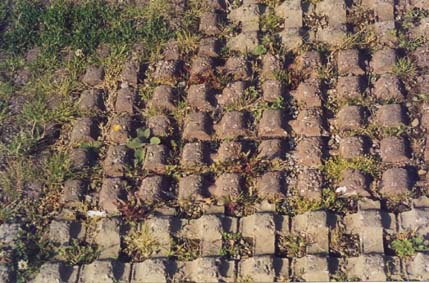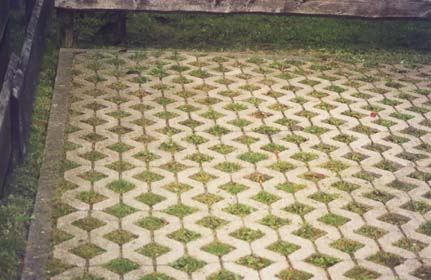Contents
Water conservation inside and outside the house
Part of a set of pages devoted to building an energy efficient house. As the building progresses, we are now able to focus on ways to conserve water and energy outside as well as inside the house.Minimizing water usage both inside the house (see appliances) and outside the house is a goal that seems strange in a house right next to a Great Lake, but none-the-less is important. A useful guide to water conservation comes from the California Urban Water Conservation Council. Inside the house, low flow showerheads and dual flush toilets cut down water consumption. The H2Ouse.org web page points out that instant hot water does not actually seem to save any water (and probably increases energy usage because of heat loss to the system). One technique that would be useful in the garden is "rain harvesting".
Caroma toilets, manufactured in Australia but available in the US, offer dual flushing, with a .8 gpf for low and 1.6 gpf for high.
Water conseration by reducing runoff
Runoff from driveways is typically diverted into storm sewers rather than into the ground. An alternative is the use of porous or grassy pavers that allow the water to be absorbed into the ground. Samples from Scotland and Germany show some of the possibilities. By using such tiles we will reduce surface runoff at the cost of increasing the subsoil water table. (See the Nemo project, Nonpoint Education for Municipal Officials, web page for a discussion of how to prevent runoff and further considerations of municipal planning for water use). Grass pavers can be made of plastic (e.g., Grassy Pavers(TM)) or concrete. The NEMO page has a comparison of different products One decision is between concrete and plastic pavers. Most plastic grassy pavers seem to be made of recycled plastic. Invisible Structures has an interesting web page showing their product being used for parking lots at football stadiums and malls.


We installed grassy pavers as well as porous pavers.  Grassy pavers similar to the ones we had seen in Germany. We had considered a number of different types but chose the concrete ones where the grass grows through them. We put the pavers in in early June, planted grass seed immediately, and within 2 days were driving trucks and cars over the pavers. Even with this treatment, the grass has grown up to the point where we need to mow our driveway.
Grassy pavers similar to the ones we had seen in Germany. We had considered a number of different types but chose the concrete ones where the grass grows through them. We put the pavers in in early June, planted grass seed immediately, and within 2 days were driving trucks and cars over the pavers. Even with this treatment, the grass has grown up to the point where we need to mow our driveway.
Water conservation by using cisterns
The average annual rainfall in Evanston is about 35 inches. The monthly averages for May-September are about 4 inches/month with a record high of 6 inches in one day. Given a house with roughly 2500 square feet of roofing, this means that roughly 800 cubic feet or 6,000 gallons of water are drained off of the roof/month during the summer. If this amount of water is merely dumped on the surface, some of it will be absorbed by the vegatation but much of it, particularly during a heavy storm, will run off into the lake or into the sewer system. (There is a small collection and sedimentation basin that then drains into the sewer. This drain has a 3 inch constrictor.)
An alternative to having the runnoff go to the lake or the sewer is to have a larger catchbasin/cistern that then slowly releases the water to the soil. Such cisterns can become contaminated with bird droppings and other pollution on the roof, but techniques such as SafeRain allow one to divert the first amount of water and then catch the later runoff. A garden water saver diverts the water from the normal downspout to fill a tank. When the tank is full, the water is then allowed to run directly down the downspot the the standard drain.
Consider a 1 inch rainstorm: 2500 square feet results in roughly 200 cubic feet of rain water or 1,500 gallons. If this water were then slowly released to the garden over the next several days rather than running into the sewer and lake it would help the garden and lake. Slow drainage could be achieved by the logical equivalent of a septic field distribution system.
How would this work? Recessed tanks, lined with cistern liners under the front porch and lake side terrace would be slightly above the current grade. This would allow them to fill from the rain spout/gutter system and then slowly drain into the garden areas around the house. This is consistent with the original engineering drawings, but replaces the retention tank at the low point in the yard with several closer to the house.
How big should such containers be? Assuming that the terrace is roughly 200 square feet. Then a two foot deep container would be able to catch all the flow from a 2 inch rain. This container would be supplemented with a 12 foot by 6 foot by 2 foot (144 cubic feet) container under the front porch. An alternative location for the collection tanks would be under the solar collectors by the garage. This would allow for easier access if it were necessary to clean the tanks.
We have installed a 1000 gallon (roughly 120 cubic foot) tank on the SE side of the house. Most of the rain downspouts connect to the cistern. We are putting in a small pump and a house bib to allow us to use this water for watering the garden. We have not put in the early rain diverters so we will see how much a problem bird droppings and leaves really are. Overflow from the cistern flows onto the grass.